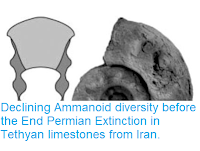The Royal Canadian Mounted Police is mounting an investigation after two men were seen stealing a rare Ammonite from a mine in Lethbridge in southwestern Alberta on Thursday 18 July 2019. Ammonites are extremely common fossils in Mesozoic marine deposits, and are not generally considered to be particularly valuable, however the Late Cretaceous shales at Lethbridge produces large Ammonite fossils comprised of a mineral called Ammolite, which is valued as a gemstone by jewelry makers, and has resulted in Lethbridge becoming home to what is probably the world's only commercial Ammonite mine. The specimen was seen being removed in broad daylight by workers at the other end of the open pit mine, but the thieves managed to escape before the miners could reach them. It has an estimated value of about Canada $50 000 (about US$38 250).
An Ammolite Ammonite from the Lethbridge Ammonite Mine. Minedat.
Ammonites are almost ubiquitous fossils in Mesozoic Marine deposits, and
as such have been used extensively in interpreting and dating these
deposits. They were free-swimming Cephalopods, related to modern
Octopus, Squid, Cuttlefish and Nautiloids, and like many other Molluscs are
thought to have had shells comprised primarily of aragonite, a form of calcium carbonate less stable than the more widely found calcite (the primary mineral in limestone and marble). Aragonite has a sheen not present in calcite (it is the primary mineral in nacre, or mother of pearl), but because it is unstable most fossils of Ammonites (and other originally aragonitic shells) are generally recrystalised as calcite. The Lethbridge Ammonites, however, are still comprised primarily of aragonite, but have absorbed a number of metal ions from their environment, including : aluminium; barium; chromium; copper; iron; magnesium; manganese; strontium; titanium; and vanadium.This gives the fossils both a distinctive sheen and a unique colouration, which is marketed as the gemstone Ammolite.
See also...
See also...
Follow Sciency Thoughts on Facebook.







